1950s
Kurvon Breast Enhancement Pills
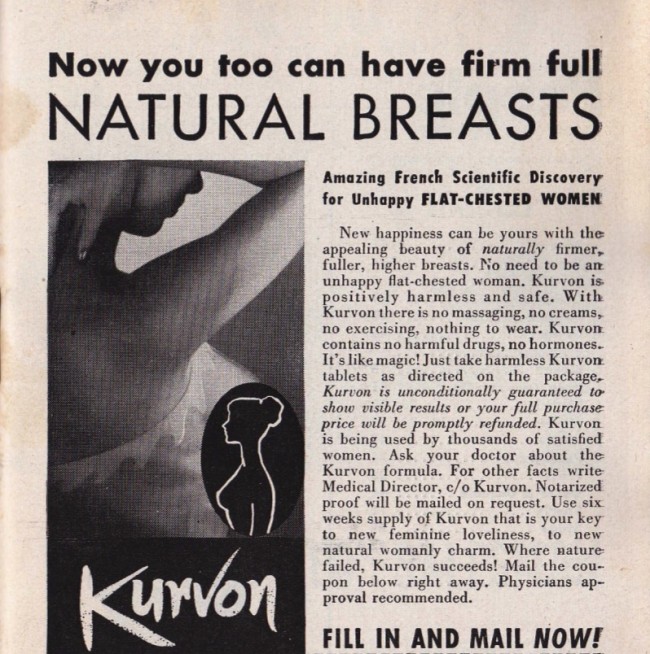
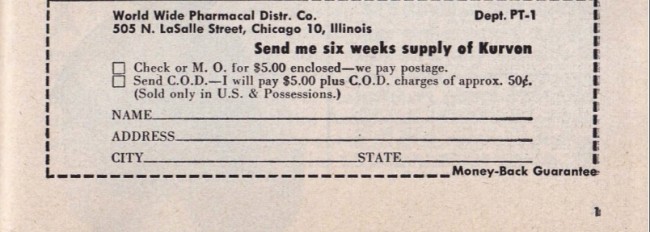
[Click to enlarge--ha!]
There's a great story behind this pill, wherein an ex-employee tried to rip off the formula and sell it as "Charm-on." Read it here.
Did you know breast-boosting pills are still for sale?
Original ad scanned from this magazine:
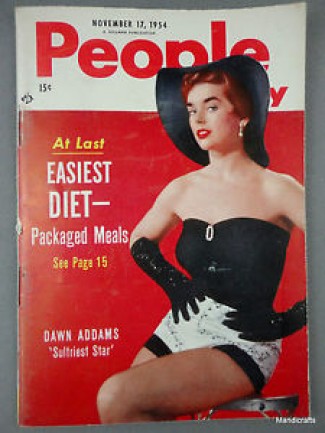
Posted By: Paul - Tue Oct 13, 2015 -
Comments (8)
Category: Body Modifications, Lawsuits, 1950s
The Hideous Sun Demon
Posted By: Paul - Mon Oct 05, 2015 -
Comments (4)
Category: Ineptness, Crudity, Talentlessness, Kitsch, and Bad Art, Movies, Atomic Power and Other Nuclear Matters, 1950s, Fictional Monsters
Cheerleader drops dead after team loses
1953: Diane Rinkes, 15-year-old cheerleader for East Lansing high school in Michigan, gave it her all for her team, but it wasn't enough. Her team lost, and then she dropped dead.When I first read this story, I assumed that there must have been some kind of underlying medical condition that caused her death. 15-year-old girls don't simply drop dead for no reason.
But in a follow-up report it says that the Coroner diagnosed the cause of death as "acute shock and acute circulatory collapse... brought on by overexertion." He elaborated that Rinkes worked herself up into such a "tremendous pitch of excitement during the football game" that it caused her death.
So she died of over-excitement. You have to wonder if she would have lived if her team had won.
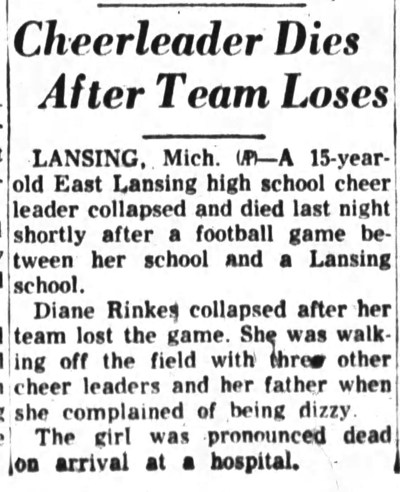
The Anniston Star - Sep 25, 1953
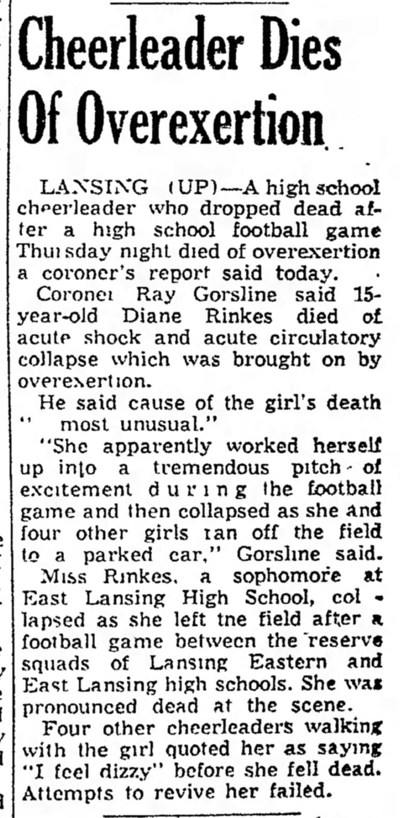
The Holland Evening Sentinel - Sep 25, 1953
Posted By: Alex - Wed Sep 30, 2015 -
Comments (5)
Category: Death, Exercise and Fitness, 1950s
How to recognize abnormal people
In the late 1950s, Drs. Robert Matthews and Lloyd Rowland wrote a police training manual titled "How to Recognize and Handle Abnormal People," which was then distributed to sheriff and police departments throughout the U.S. The officers receiving it in the photo below look a little skeptical.Check out more scans from the book at Print magazine.


The Bloomington Pantagraph - May 2, 1958
Posted By: Alex - Tue Sep 29, 2015 -
Comments (8)
Category: Police and Other Law Enforcement, 1950s
Bond Clothing Sign, NYC
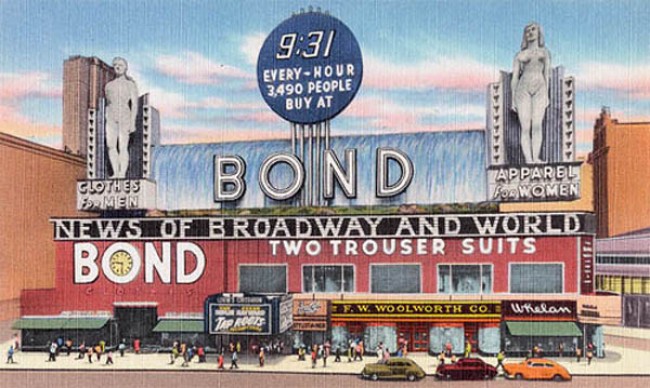
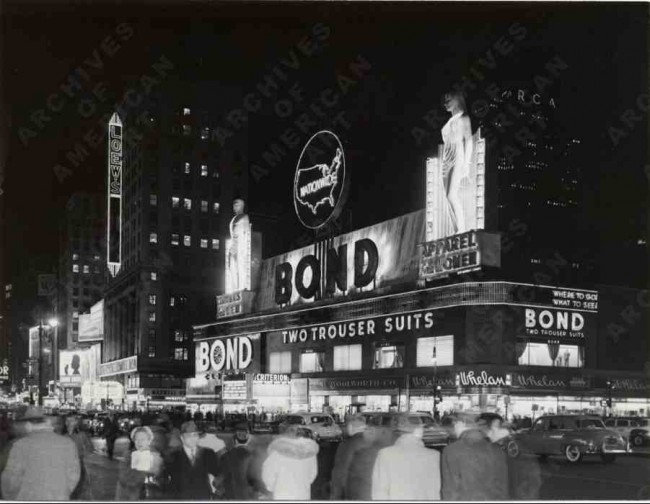
The Wikipedia entry tells us:
Between 1948 and 1954, Bond Clothes operated a massive sign on the east side block of Broadway between 44th and 45th streets in New York's Times Square. The sign had nearly 2 miles of neon and included two 7-story-tall nude figures, a man and a woman, as bookends. Between the nude figures, there was a 27-foot-high (8.2 m) and 132-foot-wide (40 m) waterfall with 50,000 gallons of recirculated water. Beneath the waterfall was a 278-foot-long (85 m) zipper sign with scrolling messages. The Bond zipper was made up of more than 20,000 light bulbs. Above the waterfall was a digital clock with the wording "Every Hour 3,490 People Buy at Bond."[7] Some of the sign remained in place to advertise the Bond Stores location until the stores closure in 1977.
Posted By: Paul - Mon Sep 28, 2015 -
Comments (3)
Category: Beauty, Ugliness and Other Aesthetic Issues, Signage, 1940s, 1950s
Jayne Mansfield’s Hand
1958: Journalist tries to record in words the exact sensation of touching Jayne Mansfield's hand.I had never seen the phrase "gone sensation" and thought maybe it was a typo, but Merriam-Webster defines it as "a feeling of faintness or weakness."
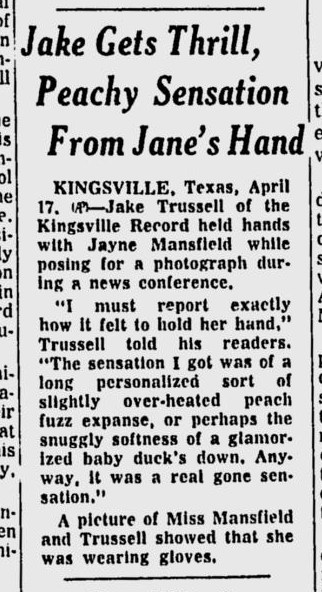
Spokane Daily Chronicle - Apr 17, 1958
KINGSVILLE, Texas, April 17. — Jake Trussell of the Kingsville Record held hands with Jayne Mansfield while posing for a photograph during a news conference.
"I must report exactly how it felt to hold her hand," Trussell told his readers. "The sensation I got was of a long personalized sort of slightly over-heated peach fuzz expanse, or perhaps the snuggly softness of a glamorized baby duck's down. Anyway, it was a real gone sensation."
A picture of Miss Mansfield and Trussell showed that she was wearing gloves.
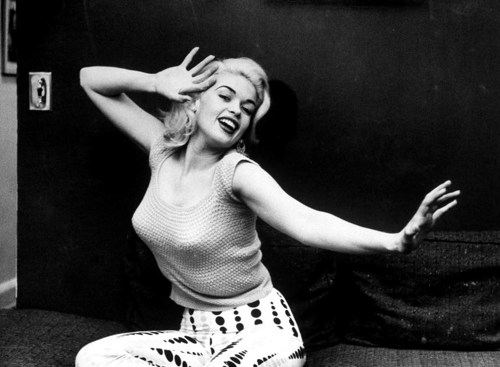
Posted By: Alex - Sat Sep 26, 2015 -
Comments (13)
Category: Celebrities, Sex Symbols, 1950s
Kaywoodie Chinrester
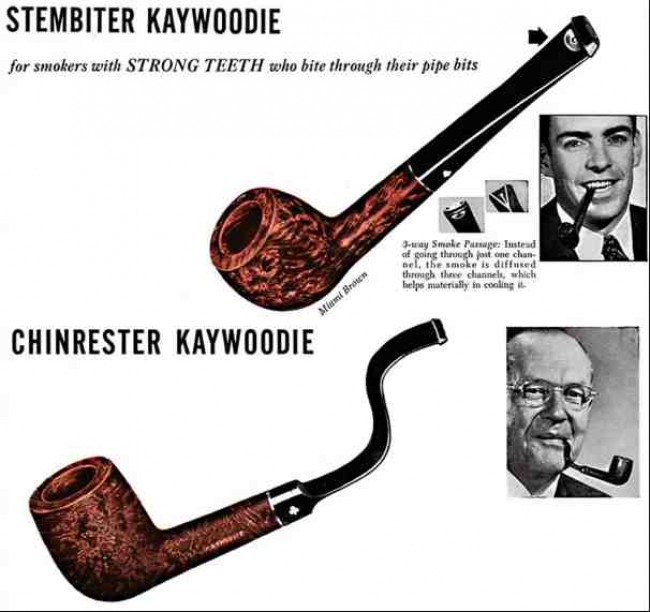
Posted By: Paul - Mon Sep 21, 2015 -
Comments (4)
Category: Tobacco and Smoking, Chindogu, 1950s
Keeping Mentally Fit
Is the narrator drunk? Of just folksy?
The lesson learned: look around you and you will probably spot a lunatic.
Posted By: Paul - Fri Sep 18, 2015 -
Comments (4)
Category: PSA’s, 1950s, Diseases, Mental Health and Insanity
Powering Entire Neighborhood
Having done some home wiring, this impresses me as a truly epic screw-up. And I'm curious how the workmen could have managed to wire up something like this accidentally.Based on the description (the fact that the homeowner had to switch off the main power feed and not just one circuit to turn off the street lights), I'm guessing that the workmen must have somehow got power going back out of the house through the neutral line, and then fed this into the street lights.
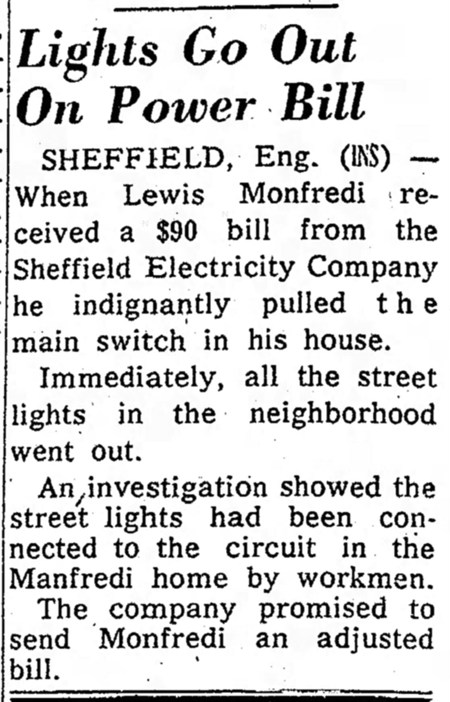
News-Journal (Mansfield, Ohio) - Jan 26, 1957
SHEFFIELD, Eng. — When Lewis Monfredi received a $90 bill from the Sheffield Electricity Company he indignantly pulled the main switch in his house. Immediately, all the street lights in the neighborhood went out.
An investigation showed the street lights had been connected to the circuit in the Manfredi home by workmen. The company promised to send Monfredi an adjusted bill.
Posted By: Alex - Sun Sep 13, 2015 -
Comments (8)
Category: Utilities and Power Generation, 1950s
Bond Mini Car
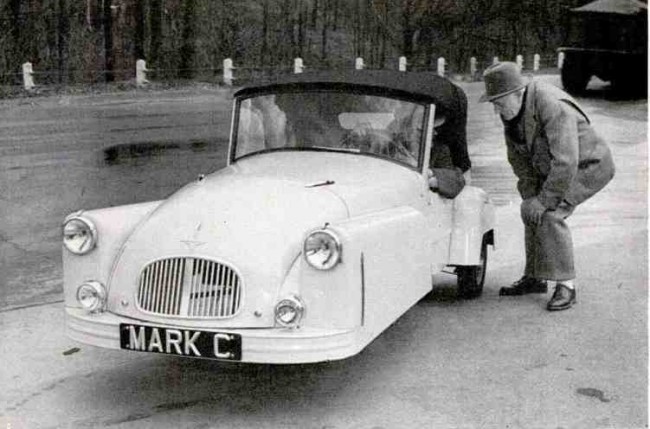
If you took a three-wheeled motorcycle and dropped the shell of an auto atop it, this is what you would get. Lift the hood of the "car," and there is the engine riding on a single steerable wheel of its own
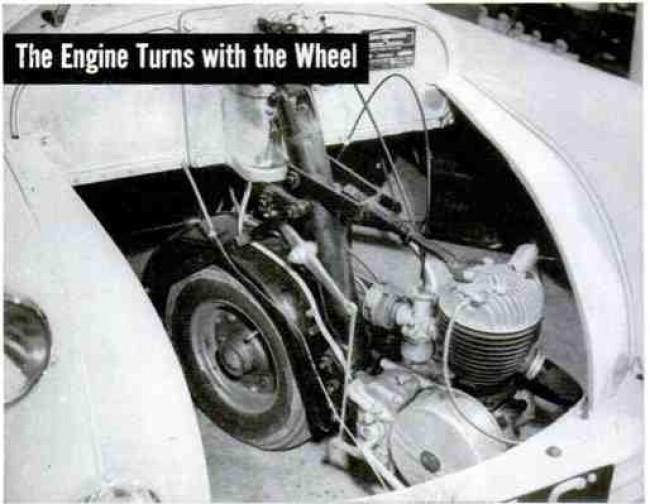
Wikipedia article here.
POPULAR SCIENCE article here.
Posted By: Paul - Sat Sep 12, 2015 -
Comments (3)
Category: 1950s, Europe, Cars, Motorcycles

| Who We Are |
|---|
| Alex Boese Alex is the creator and curator of the Museum of Hoaxes. He's also the author of various weird, non-fiction, science-themed books such as Elephants on Acid and Psychedelic Apes. Paul Di Filippo Paul has been paid to put weird ideas into fictional form for over thirty years, in his career as a noted science fiction writer. He has recently begun blogging on many curious topics with three fellow writers at The Inferior 4+1. Contact Us |




